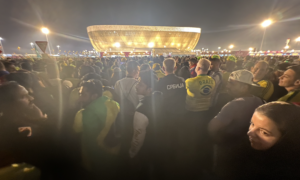Michael Bradley stunned Mexico with his sixth minute golazo at Estadio Azteca, but Mexico fought back well, and equalised through Carlos Vela. Mexico enjoyed a remarkable 73% possession across the match, but couldn’t find a winner, as the US defence held firm. Here’s Tom Harrison with his tactical takes from the World Cup qualifier.
Herrera thrives as the deep-lying playmaker
The loss of Andrés Guardado appeared a massive blow. Filling his shoes in the deep-lying playmaker role was a huge challenge for any player, a challenge that was handed to Héctor Herrera. Herrera has played more minutes than anyone else under Juan Carlos Osorio, but has been used in a more advanced role, and has often underwhelmed.
As the deep-lying playmaker, Herrera was superb. Helped by Jonathan Dos Santos’ forward runs, Herrera consistently played penetrating and splitting passes, which broke through the US’ midfield, taking them out of the game.
One of Herrera's best performances for Mexico… #ElTriEng pic.twitter.com/S5ZVvvRonl
— Tom Harrison (@tomh_36) June 12, 2017
A penetrating pass isn’t as eye-catching as a player dribbling past an opponent, but it has more or less the same effect, taking a defender out of the game.
HH also managed to maintain an extremely high passing accuracy, 89%, despite regularly attempting these penetrating, forward passes.
The only criticism is that Herrera didn’t display the range of passing that Andrés Guardado has, with few long passes to switch the play out wide. But overall, the Porto midfielder was fantastic is so many aspects of the game. With the confidence of consistently completing passes, Herrera also made three tackles, an interception, and hit the bar with a stunning free-kick.
Defensive concerns remain
On a massive Azteca pitch, with an attacking line-up and mentality, it was inevitable that Mexico would leave gaps at the back. At the start of the match, this was a massive problem.
Whilst Michael Bradley’s goal was incredible, it’s concerning that one slightly misplaced pass led to the American being through on goal.
ICYMI: Michael Bradley caught Memo Ochoa off his line to open the scoring for the #USMNT. Watch it again. #ElTriEng pic.twitter.com/rwBITEHiRD
— Fut Mex Nation (@FutMexNation) June 12, 2017
The US threatened a couple of times afterwards to break through on goal as well, with the offside flag preventing Bobby Wood from having one-on-one opportunities.
Playing a high line on such a huge pitch, with four centre-backs in defence, and therefore a lack of pace, was always a recipe for disaster.
Defensive solidity improved when the pacey Jesús Gallardo replaced Oswaldo Alanís at left-back, but Mexico’s 73% possession and the US’ containing mentality were the main reasons why El Tri weren’t troubled much for the remainder of the encounter.
73% possession, but just a single shot on target
And only four attempts inside the box, the same number as the US. The US and Bruce Arena deserve plenty of credit for successfully executing their game plan and coming away with a point. They sat deep with five across the back, and packed the space in and around their box.
When Mexico tried to play through the middle, they found very little space. Joy was found in one-v-one situations out wide, Jesús Gallardo being particularly successful on the left flank after coming on. However, the US were all too comfortable dealing with the resulting crosses. The standard of crossing wasn’t particularly poor, Mexico just weren’t set up to be a threat from crosses, with Javier Hernández facing the prospect of three centre-backs who exceed 6’1″.
Mexico’s only goal of the game came from a counter attack, an indication of how effective the US were at negating threats when Mexico had possession.
What Memo mistake?
Carlos Vela brought México level at 1-1 in min. 22 with this dribble & finish.#ElTriEngpic.twitter.com/bHHZ4kQUgH
— Fut Mex Nation (@FutMexNation) June 12, 2017
Chucky Lozano neutralised by Bruce Arena’s tactics
On his day, Hirving “Chucky” Lozano is a devastating attacking player. But he has the potential to be neutralised, as he was on Sunday.
Bruce Arena’s deep, defensive style prevented Lozano from being a threat at Estadio Azteca, the stadium where Chucky first burst on to the scene when scoring a debut goal for Pachuca.
Much more of a goal scorer than creator, Lozano possesses two main threats. The most obvious one is to start wide on the left flank, cut inside onto his stronger right-foot, and strike at goal. The US’ five-man defence prevented this from being possible, as whenever Hirving cut inside, he faced one or two defenders, and couldn’t find space to shoot. Lozano completed just one of five dribble attempts on Sunday.
The more underrated part of Chucky’s game is his off-the-ball movement. The Pachuca forward gets so many goals by making intelligent, and fast, runs in-behind opposition defences. With the USA holding a deep line on Sunday, Chucky rarely had space to run into. There were two occasions when he had begun to make a forward run, but the through ball towards Lozano was good enough.
Osorio tried to change his fortunes by switching Hirving from the left to the right, but it made little difference.
As Chucky doesn’t possess the creativity of Jesús “Tecatito” Corona, he can often be a less effective player. With Tecatito out of the Confederations Cup, this is a bit of a concern.
Mexico can cope mentally without Rafa, or Guardado
Few would argue that Rafa Márquez still deserves to be part of the Mexico side based on ability alone. However, El Kaiser is a leader for El Tri, and there’s a belief that having him in the side improves the performance, and mental state, of players around him. Without him, the team can fall apart, like in the defeat to Chile.
Mental tests don’t get much tougher than Sunday’s game. Mexico were without Rafa, and their second best leader, Andrés Guardado. Furthermore, the match was taking place in front of an unforgiving Azteca crowd, and they went a goal down in the sixth minute.
The potential for a collapse was there, but it didn’t materialise. Mexico settled, significantly improved their organisation, and quickly managed to cut out the US’ threat on the counter. This was helped by the US sitting very deep and committing few players to attack, but El Tri’s players still deserve credit for their mental response. Evidently, Mexico are capable of coping mentally without Rafa.
Comments








